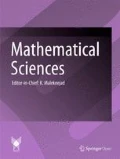Abstract
Data envelopment analysis (DEA) technique is commonly utilized for efficiency assessment in a variety of fields for both theoretical and applicational purposes. In classic cost efficiency measurement models, the input and output data and input prices should be known for each decision-making unit (DMU). However, in real-life markets the input prices are not precisely defined for DMUs. In this paper, we shed light on the fact that fixed prices assumption cannot reflect the reality of situations, because market will force lower prices if greater amounts of a product are purchased. It can be said that discounts are automatically considered in these circumstances. To this end, an innovative idea is considered to modify the classic cost efficiency DEA model in order to investigate the situations of real-life markets. Then, by an empirical example, a comparison between the proposed approach and the classic cost efficiency model is provided.



Similar content being viewed by others
References
Farrell, M.J.: The measurement of productive efficiency. J. R. Stat. Soc. 120, 253–81 (1957)
Fare, R., Grosskopf, S., Lovell, C.A.K.: The Measurement of Efficiency of Production. Kluwer Academic Publisher, Dordrecht (1985)
Tone, K.: A strange case of the cost and allocative efficiencies in DEA. J. Oper. Res. Soc. 53, 1225–31 (2002)
Cooper, W.W., Thompson, R.G., Thrall, R.M.: Extensions and new developments in DEA. Ann. Oper. Res. 66, 3–45 (1996)
Lee, C.C., Huang, T.H.: Cost efficiency and technological gap in Western European banks: a stochastic meta frontier analysis. Int. Rev. Econ. Finance 48, 161–178 (2017)
Cesaroni, G.: Industry cost efficiency in data envelopment analysis. Socio-Econ. Plan. Sci. 61, 37–43 (2018)
Ashrafi, A., Kaleibar, M.M.: Cost, revenue and profit efficiency models in generalized fuzzy data envelopment analysis. Fuzzy Inf. Eng. 9, 237–246 (2017)
Ajayi, V., Weyman-Jones, T., Glass, A.: Cost efficiency and electricity market structure: a case study of OECD countries. Energy Econ. 65, 283–291 (2017)
Geng, A., Zhang, H., Yang, H.: Greenhouse gas reduction and cost efficiency of using wood flooring as an alternative to ceramic tile: a case study in China. J. Clean. Prod. 166, 438–448 (2017)
Preciado-Pérez, O.A., Fotios, S.: Comprehensive cost-benefit analysis of energy efficiency in social housing. Case study: Northwest Mexico. Energy Build. 152, 279–289 (2017)
Hasançebi, O.: Cost efficiency analyses of steel frameworks for economical design of multi-storey buildings. J. Constr. Steel Res. 128, 380–396 (2017)
Blagojević, M., Ralević, P., Šarac, D.: An integrated approach to analysing the cost efficiency of postal networks. Util. Policy (2020). https://doi.org/10.1016/j.jup.2019.101002
Sapci, A., Miles, B.: Bank size, returns to scale, and cost efficiency. J. Econ. Bus. (2019). https://doi.org/10.1016/j.jeconbus.2019.04.003
Obenga, K., Sakano, R.: Effects of government regulations and input subsidies on cost efficiency: a decomposition approach. Transp. Policy 91, 95–107 (2020)
AliAl-Khasawneh, A., Essaddam, N., Hussain, T.: Total productivity and cost efficiency dynamics of US merging banks: a non-parametric bootstrapped analysis of the fifth merger wave. Q. Rev. Econ. Finance (2020). https://doi.org/10.1016/j.qref.2020.02.002
Camanho, A.S., Dyson, R.G.Dyson: Cost efficiency measurement with price uncertainty: a DEA application to bank branch assessments Dordrecht MA. Eur. J. Oper. Res. 161, 432–446 (2005)
Jahanshahloo, G.R., Soleimani-damaneh, M., Mostafaee, A.: Cost ef ficiency analysis with ordinal data: a theoretical and computational view. Int. J. Comput. Math. 84, 553–562 (2007)
Kuosmanen, T., Post, T.: Measuring economic efficiency with incomplete price information: With an application to European commerical banks. Eur. J. Oper. Res. 134, 43–58 (2001)
Kuosmanen, T., Post, T.: Measuring economic efficiency with incomplete price information. Eur. J. Oper. Res. 144, 454–457 (2003)
Mostafaee, A., Saljooghi, F.H.: Cost effficiency measures in data envelopment analysis with data uncertainty. Eur. J. Oper. Res. 202, 595–603 (2010)
Grieco, P., Pinkse, J., Slade, M.: Brewed in North America: mergers, marginal costs, and efficiency. Int. J. Ind. Organ. 59, 24–65 (2017)
Timilsina, G.R., Sikharulidze, A., Karapoghosyan, E., Shatvoryan, S.: Development of marginal abatement cost curves for the building sector in Armenia and Georgia. Energy Policy 108, 29–43 (2017)
Batarce, M.: Estimation of urban bus transit marginal cost without cost data. Transp. Res. Part B: Methodol. 90, 241–262 (2016)
Biskas, P.N., Bakirtzis, G.A., Chatziathanasiou, V.: Computation of strict long-run marginal cost for different HV consumers. Electr. Power Syst. Res. 128, 66–78 (2015)
Cook, D.W., Zhu, J.: Piecewise linear output measure in DEA. Eur. J. Oper. Res. 197, 312–319 (2009)
Lotfi, F.H., Rostay-Malhkalife, M., Moghaddas, Z.: Modified piecewise linear DEA model. Eur. J. Oper. Res. 205, 729–733 (2010)
David Cummins, J., Rubio-Misas, M., Vencappa, D.: Competition, efficiency and soundness in European life insurance markets. J. Financ. Stabil. 28, 66–78 (2017)
Eling, M., Schaper, P.: Under pressure: how the business environment affects productivity and efficiency of European life insurance companies. Eur. J. Oper. Res. 258, 1082–1094 (2017)
Biener, C., Eling, E., Hendrik Wirfs, J.: The determinants of efficiency and productivity in the Swiss insurance industry. Eur. J. Oper. Res. 248, 703–714 (2016)
Wanke, P., Pestana Barros, C.: Efficiency drivers in Brazilian insurance: a two-stage DEA meta frontier-data mining approach. Econ. Model. 53, 8–22 (2016)
Jarray, B., Bouri, A.: Optimal production plan and profit efficiency in European non-life insurance companies. Procedia Econ. Finance 13, 69–81 (2014)
Hu, H.H., Qi, Q., Yang, C.H.: Analysis of hospital technical efficiency in China: effect of health insurance reform. China Econ. Rev. 23, 865–877 (2012)
Author information
Authors and Affiliations
Corresponding author
Additional information
Publisher's Note
Springer Nature remains neutral with regard to jurisdictional claims in published maps and institutional affiliations.
Rights and permissions
About this article
Cite this article
Lotfi, F.H., Amirteimoori, A., Moghaddas, Z. et al. Cost efficiency measurement with price uncertainty: a data envelopment analysis. Math Sci 14, 387–396 (2020). https://doi.org/10.1007/s40096-020-00349-2
Received:
Accepted:
Published:
Issue Date:
DOI: https://doi.org/10.1007/s40096-020-00349-2
Keywords
- Data envelopment analysis
- Cost efficiency
- Mixed integer programming
- Marginal value
- Piecewise linear functions


